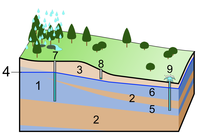
Photo from wikipedia
With the development of economy and society, deep groundwater exploitation has intensified, even to the point of over-exploitation, resulting in multiple geological disasters. Thus, it is essential to regulate the… Click to show full abstract
With the development of economy and society, deep groundwater exploitation has intensified, even to the point of over-exploitation, resulting in multiple geological disasters. Thus, it is essential to regulate the deep groundwater table to a reasonable range. This paper selected the water intake area of the South-to-North Water Transfer Project in Tianjin as a case study. First, the groundwater flow and land subsidence model with MODFLOW-2005 and SUB Package were constructed. Second, the regulation schemes were designed based on the corresponding regulation principles. Lastly, the established groundwater model was adopted to forecast and simulate deep water table and land subsidence under different exploitation scenarios, and regulation effects were analyzed from the viewpoints of exploitation total amount, exploitation distribution, and exploited horizon. The results showed that groundwater tables of different layers and land subsidence were effectively controlled and improved under the three exploitation schemes for different planning level years. The exploitation total amount of groundwater, exploitation distribution, and exploited horizon had a direct impact on water table and land subsidence. From the perspective of regulating deep groundwater, all three schemes could achieve this goal, hence the three schemes were reasonable and feasible. The results are of great significance for rational utilization of deep groundwater.
Journal Title: Journal of Hydroinformatics
Year Published: 2018
Link to full text (if available)
Share on Social Media: Sign Up to like & get
recommendations!